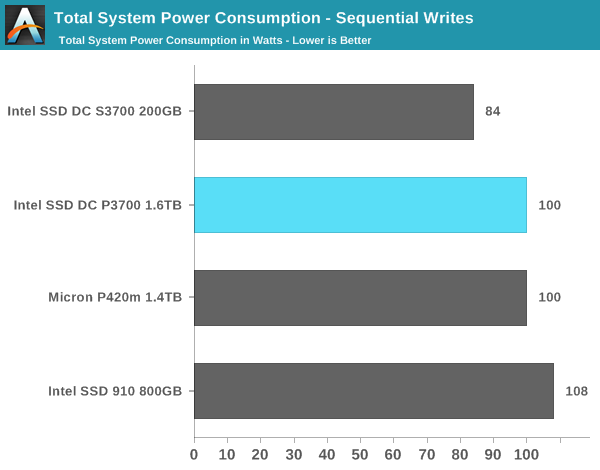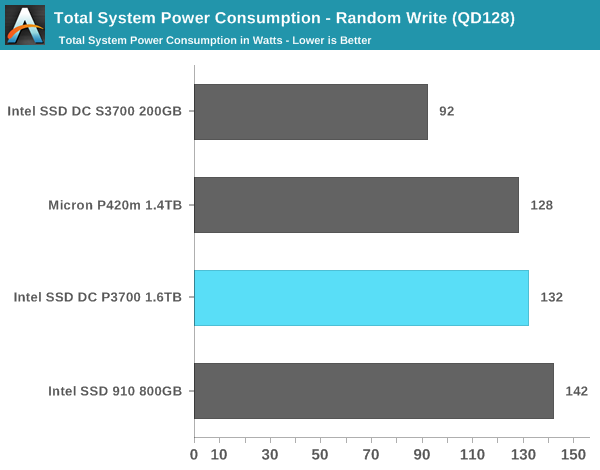Intel SSD DC P3700 Review: The PCIe SSD Transition Begins with NVMe
by Anand Lal Shimpi on June 3, 2014 2:00 AM EST- Posted in
- Storage
- SSDs
- Intel
- Intel SSD DC P3700
- NVMe
Power Consumption
To quantify power consumption we're looking at total system power, which takes into account the CPU load associated with workload generation as well as the power drawn by the drive itself. The P3700 was left in its default lower power operating mode, not the higher 25W mode.
Overall the P3700 doesn't raise any power consumption flags. The overall system power consumption ends up being around 16W higher than with a single S3700, but if you normalize for performance the two end up looking quite similar. There seems to be some power savings compared to the old Intel SSD 910, and roughly comparable power consumption to the P420m.












85 Comments
View All Comments
Ammaross - Tuesday, June 3, 2014 - link
The M.2 SATA-protocol-on-PCIe drives? A comparison would mean Apple would need have to have support for NVMe first or the ability to even slot in such a card (rules out the 3 offerings you outlined).extide - Tuesday, June 3, 2014 - link
What are you talking about? "The M.2 SATA-protocol-on-PCIe drives?" doesn't even make sense.All you need to do to compare them is run the benchmarks on the apple hardware, possibly while running under a windows OS. OR, if the drives use the regular m.2 style connector you could just stick them in a desktop. The fact they run AHCI over PCIe does not make a comparison impossible, in fact all of the other PCIe cards in this review that were benchmarked against were also AHCI based cards. Seems like NVMe is confusing people at lot more than it should.
Galatian - Wednesday, June 4, 2014 - link
I think he tried to say that you can't stick one of those new NVMe drives into a Mac, since OS X does not yet support NVMe.That being said, Apple discontinued the old Mac Pro where you could put a PCIe device inside, so the point is moot no matter what.
gospadin - Tuesday, June 3, 2014 - link
I'd have liked to see the drive in 25W mode tooextide - Tuesday, June 3, 2014 - link
Yeah, I would as well. I am assuming the 25W mode has specific cooling requirements? More info on this would be nice. Also what is the default TDP?eanazag - Tuesday, June 3, 2014 - link
That's also the first thing I thought. I wanted to see the boost level. That bottom is pretty close to where I would consider splurging for my desktop with a 400GB. If you consider a RAID card and few drives then $600 is justifiable.I stayed away from the PCIe SSDs because of boot issues and quality concerns. A lot of those were OCZ.
Galatian - Tuesday, June 3, 2014 - link
I might have just overlooked it, but I guess those drives are not bootable?457R4LDR34DKN07 - Tuesday, June 3, 2014 - link
" Booting to NVMe drives shouldn't be an issue either."Galatian - Tuesday, June 3, 2014 - link
Ah great...so this might be a nice alternative to the lackluster state M.2 is right now after all!dopp - Tuesday, June 3, 2014 - link
NVMe won't necessarily be a replacement for M.2. M.2 is just the connector, and the M.2 standard supports both SATA and NVMe as protocols to control the SSD. That said, you need a motherboard that's wired to give PCIe-over-M.2 as well as a drive that supports NVMe, and NVMe M.2 drives will likely be much better than SATA ones.